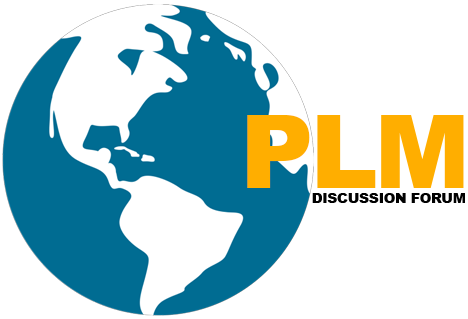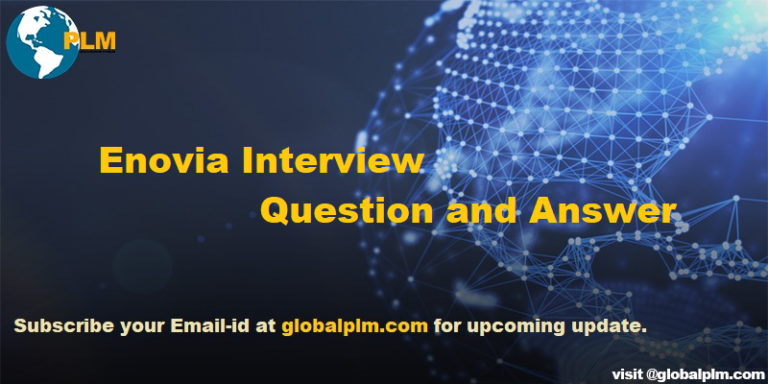Enovia Interview Question and Answer
Q1.What are eMatrix Components?
Ans: The eMatrix system is a client/server software suite consisting of the following components:
System Manager: The System Manager application is used to perform activities related to the configuration and maintenance of database storage locations.
Business Modeler: Business Modeler application is pre-owned to model the types of objects used in your business, along with attributes, process rules, and persons associated with those items. Your business model defines how you will use eMatrix and can be changed as often as your business needs change.
eMatrix Navigator: The eMatrix Navigator application is used to create specific instances of the objects that were defined in the Business Modeler.
MQL: Matrix Query language for querying the matrix Database.
Q2.What is Matrix Query Language (MQL)?
Ans: The MQL application uses a command-driven interface to all of the above components. The MQL language helps the Business or System Administrator set up and test an eMatrix database quickly and efficiently. The MQL language can be used within the Business Modeler to create custom programs that allow you to tailor eMatrix to your specific business needs.
In addition to the applications listed above, the following components are also provided as part of the eMatrix system:
Q3.What are all the other components along with the Matrix components?
Q4.What is eMatrix Adaplet™ Development Kit?
Ans: Adaplets™ can be written that allow data from virtually any source to be modeled as eMatrix business objects, allowing legacy systems to coexist with eMatrix.
Q5.Where does eMatrix look for all the classes and library files if needed?
Ans: C:\eMatrix\java\classes;
C:\eMatrix\java\lib;
Q6.What is the importance of Properties file? (“C:\eMatrix\java\properties”)
Ans: For configuring the clients and for integration.
Q7.What is Object Lifecycle?
Q8.Who/How A business object is controlled by its policy?
Q9.What are Different types of vaults by default?
Ans:eServeiceSamples; eServiceProduction; eServiceAdministration;p Administration.
Enovia Interview Question and Answer|Set6
Q10.Where do JPO’s Run in Ematrix?
Ans: They run in matrix core kernel. (i.e RMI).
Q11.What is Packing and Packing of Arguments in matrix?
Ans: This is process similar to that of serializations.
Q12: What is the difference between Alternate Part & Substitute part?
Ans: Substitute part is only for a particular part in that assembly only but whereas the alternate part is for the part anywhere in any assemblies.
Q13.Who is default user for Navigator?
Ans: Creator.
Q14.Who is default user for System?
Ans: “Creator” as a normal user.
“Administrator User” as an admin. This is a Hidden Person who will not be shone on the system.
Q15.Who is default user for Business?
Ans: Creator; He creates the Schemas of a Business Specifications.
Q16. Matrix Schema Development steps?
Ans: 1.Plan & Define initial matrix Schema
2.Map Definations.
3.Test & Revise defines definations.
4.Maintain & Definitions & Updates.
Q17. How do you create bootstrap file ?
Ans: Go to ematrix–>System–>Inatall –>click on Bootsrtap
Give on the “username” , “Password”, “connecting string = matrix”, database server.
One can use any user-provided user should exist in the matrix.
Q18.Where can we change the context of the matrix in System?
Ans: It can be changed through the System module. From Systemà session à click on the “context”, u can change the context of the current session.
Q19.Where can we change the context of the matrix in Business?
Ans: From Systemà session à click on the “context”, u can change the context of the current session.
Q20. Where do u create Store & Vault?
Enovia Interview Question and Answer|Set-5
Q21.What are different types of Stores?
Q22.What are different types of Vaults?
Q23. What is significance of STAGING directory in eMatrix home directory?
Q24: Give some Admin Objects present in the system?
Q25.What all an Attribute has in a matrix Schema?
Ans: Name, Description, Type, Default Value or a range (One or more ranges), Triggers. Attribute can be hidden.
Q26. What all a Type has in a matrix Schema?
Q27. How can u call a JPO from jsp?
Q28.Can you add same part to EBOM again when it’s already existing?
Ans: Yes- the only difference is that it has different reference designator and different find number.
Q29. What is the Difference Between Reference and Specification in Document?
Ans: Reference Document: This is a referral document for a part.
Specification Document: This is a design specification document such as Cad drawing sheet or any other technical design document carrying information about the specification and design.
Q30.What is relation in eMatrix?
Ans: Relation is something that associates two objects in Matrix.
Q31.Why a Relation should have attribute on it?
Q32.How can we Prevent Duplicate relations?
Q33. What is Cardinality?
Q34.What does “Propagate Modify” check option on a relation indicate?
Ans: You can choose whether or not to timestamp the objects on the ends when the relationship’s attributes are modified.
Q35. What is type of relations Exist?
Ans: None; Float; Replicate. These will describe relationship status on the objects after their state transition.
Q36.What are different states of objects in matrix?
Q37.What does Propagate Connect / Disconnect Option on the relation describe?
Ans: You can choose whether or not to timestamp the objects on the ends when the relationship’s attributes are created or deleted (connect or disconnect occurs).
Q38. What Is the length of the meaning attribute of the Relation?
Q39. What is the difference Float & Replicate on Relations?
Q40.Can you create Centrals without Frameworks?
Ans: No.
Q41.What is JPO?
Ans: Java Programming Object. This allows user to write Java code above eMatrix, Using ADK interface. JPO’s are replacements of TCL. JPO’s actually separate Business logic for from the JSP’s.
Q41.Where do JPO’s Execute/Run?
Ans: JPO’s Execute in eMatrix server, Core kernel of Collaboration kernel.
Q42.What is TCL?
Ans: Tool Command Language.
Q43. What way JPO’s replace TCL?
Ans: Performance; Reusability; Threadsafe; Object-oriented.
Enovia Interview Question and Answer|Set-4
Q44. How can you say JPO’s show more performance?
Ans: Since JPO’s are precompiled classes they execute on fly. This gives performance at server end, as once precompiled they get stored in matrix and are used as it is.
Q45. Why is JPO’s Introduced in e-Matrix?
Q46.What are the settings needed for the execution of JPO’s?
Ans: Mx_CLSSPATH in eMatrix.ini file.
Q47.What is matrix BOOTSTRAP file?
Q48.What are files that a web server needs?
Ans: config.xml — Application configuration
web.xml. —– Deploy webserver.
Q49.What is “Framework.props”?
Ans: Contains information about Config.settings for the matrix sever and server settings.
Its Located at home directory of Collaboration kernel \java\properties.
Q50.What Thick Client, Thin client, Skinny Client?
Ans:1. Standard 2 tire. – Front end is Thick Client.
- Java Applet Power Web – Thin client.
- JSP Application — Skinny Client.
Q51.What are packages imported into JPO?
Q52.How do u Refer a JPO form a JPO?
Q53.Name some of the macros used in JPO’s?
Q54.What is the signature of the jpo?
Ans: It’s Public and it constructor will accept a Context object and String array as arguments.
Q55.What is the Entry point of the JPO?
Ans: mxMain();
Q56.How do u invoke a method form a JPO?
Q57.What is the difference between Thick, Thin & Skinny Client?
Q58.What are the different modes that MQL operates in?
Q59.How do to use comments in MQL?
Q60.How do u enter into Tcl mode?
Q61.How do u start interacting with MQL?
Q62.How do u Run MQL Scripts?
Q63.How do u identify a Business Object?
Q64.What is the difference between List & Print commands in MQL?
PLM: Enovia Interview Questions And Answers
Q65.What is expand?
Q65.How do u Expand a Business Object?
Q66.What do we use temp Query?
Q67. Life cycle of ECR?
Ans:-Create–>Submit–>Evaluate–>Review–>Plan ECO–>Complete.
Q68. ECO life Cycle?
Ans:-Create–>Define Components–>Design Work –>Review –>release–>Implemented.
Q69.Part Life Cycle?
Ans:-Preliminary–>Review–>Approved–>release–>Implemented–>Obsolete
Q70. What happens when a document is checked in twice in the document central?
Q71.How do you declare a field as read-only in .jsp page?
Ans: by declaring the field as read-only.
Q72.What is resource file?
Ans: All properties files are resource files. Used for internationalization and for customization.
Q73.How many types of beans you can use in JSP page?
Q74.Why AEF?
Ans: Application Exchange Framework. It gives all basic objects such as attributes, Relations, types needed by all the centrals installed. It acts as an interface between the application and database.
Q75.What is the difference between Java class and JPO?
Ans: JPO’s are Pre-Compiled classes, which are more efficient in execution as they in the core. JPO is a source program. Java class is a Byte Code.
Q76.How do you deploy in the various servers that u have worked on (web logic/tomcat)?
Q77.How do you import dump (command)?
Ans:imp username/password@connectstring from username to username file = “full oracle dump PATH” rows=y grant=y ignore=y
Q78.What are the configuration files that control the Matrix applications?
We will more post on PLM INTERVIEW QUESTIONS–>Enovia Interview in upcoming days.
Kindly provide your valuable comment on below Comment section and also have you any question kindly ask to ASK QUESTION in FORUM. Our Team will try to provide the best workaround.
Kindly subscribe your Email-Id at (http://globalplm.com/) and drop any suggestion/queries to ([email protected]).



2 Comments
Informative blog, Thank you for sharing.
Hi..Could you please provide answers of all the questions and for all the sets.